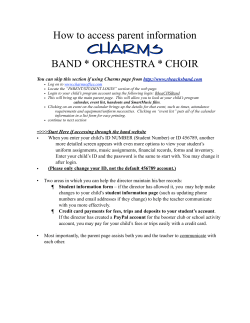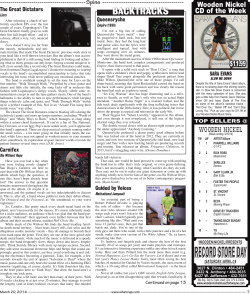
TREATMENT & TECHNIQUES
TREATMENT & TECHNIQUES Overview: Ilio-tibial band syndrome is most commonly diagnosed in the category of accident/trauma. This is usually a repetitive stress disorder due to the accumulation of micro-trauma. However, occasionally it may be seen as an acute trauma. The injury is at the level of the muscles and tendons, with qi and blood stagnation in the channels and collaterals. This case is clearly Gall Bladder meridian pathology. Sometimes the diagnosis of wind (feng) may be used for the “popping” and “snapping” pain at the lateral knee. Internal organ imbalances of the Liver and Gall Bladder frequently contribute. Prognosis: Treat twice a week for three weeks, then re-evaluate. Most cases without complications have good results within six treatments. I have confidence in the techniques that follow, which I usually communicate to the patient on the first visit. With chronic cases, continue treatment at least once weekly after the first three-week period. STEP ONE: INITIAL TREATMENT Choose among these four techniques, carefully determining if there is an immediate decrease in pain or an increase in range of motion. Technique #1: The Tendino-Muscle Meridians GB 44 Bleeding technique Treating the Gall Bladder tendino-muscle meridian may be effective for the symptoms of stiffness and tightness of the IT band. Technique #2: Opposite Side (contra-lateral) GB 33, “anterior” GB 33 Corresponding points on the opposite (unaffected) side GB 33 is located proximal to the knee joint, on the posterior side of the ilio-tibial band. “Anterior” GB 33 is located anterior to the ilio-tibial band, on the same level as GB 33. Both may be considered in contra-lateral treatment. Technique #3: Opposite Extremity (upper/lower) Corresponding points on the opposite extremity may be considered; however, treatment to the affected extremity is usually preferred. Technique #4: Empirical Points No well-known empirical points for IT band syndrome. 167 • Lateral Knee Pain Ilio-tibial Band Syndrome STEP TWO: MERIDIANS & MICROSYSTEMS Choose among these four techniques, selecting points that are appropriate for the signs and symptoms of the patient. Technique #5: The Shu-Stream Point Combination GB 41 (or GB 42) affected side + SJ 3 opposite side GB 42 is often more sensitive than GB 41, and should be considered as an alternative shu-stream point. Technique #6: Traditional Point Categories Palpation may assist in your choice of Gall Bladder meridian points. GB 40 Yuan-source point GB 43 “Water” point GB 34 He-sea point, hui-influential point of tendons GB 34 is located near the insertion site on the tibia of the IT band. GB 31 Dispels wind (feng) from the lower extremity This point is in the tissue of the ilio-tibial band itself. Its Chinese name, “wind market” (feng shi), implies its use in the treatment of wind symptoms. This includes the sudden onset, sudden disappearance, and the “snapping” of the tendon in the lateral knee. Also, the migrating pain and stiffness that often radiates up the ilio-tibial band to the pelvic region may be considered wind in nature. I often use the technique of two paired points at the region of GB 31. With perpendicular insertion into the IT band, these points are about 1 inch apart on the Gall Bladder meridian, and can be determined simply by palpation. A variation is GB 31 and GB 32 as the two paired points. Electrical stimulation on these two points may also be considered. The needle should penetrate the ilio-tibial band except for the occasional patient with such tightness that deep needling is uncomfortable. Technique #7: The Extraordinary Meridians GB 41 + SJ 5 Activate the Dai mai Frequently IT band syndrome originates from hip and gluteal imbalances, which may be considered Dai mai pathology. Bl 62 + SI 3 Activate the Yang Qiao mai The IT band produces symptoms on the lateral aspect of the thigh, which may be considered Yang Qiao mai pathology. 168 • Lateral Knee Pain Ilio-tibial Band Syndrome Technique #8: Microsystems Auricular Therapy Local: Knee (French), knee (Chinese), hip, lumbar spine Zang-fu points: Gall Bladder, Liver Systemic points for pain: Shen men, Thalamus, Adrenal, Endocrine STEP THREE: INTERNAL ORGAN IMBALANCES Choose appropriate points to treat internal organ imbalances that may contribute to the injury or pain syndrome. Technique #9: Qi, Blood, and the Zang-fu Organs Even though ilio-tibial band syndrome is a repetitive stress injury, internal organ imbalances frequently seem to contribute. Liver imbalances Liver qi stagnation, Liver yin deficiency, and Liver blood deficiency Liver imbalances may result in the susceptibility of the IT band to inflammation and repetitive stress injury. Consider the following: Liv 3 Yuan-source point; supports the Liver in its function of controlling the muscles and tendons GB 34 Hui-influential point of tendons Treat GB 34 on the affected side and Liv 3 on the opposite side. Liver and Gall Bladder damp heat Excess syndromes of the Liver and Gall Bladder are also frequently observed in the patient with IT band sydnrome. These imbalances may result in Gall Bladder meridian dysfunction, increasing the susceptibility of the ilio-tibial band to inflammation. Points should be determined by the practitioner from both palpation and analysis of the signs and symptoms of the patient. 169 • Lateral Knee Pain Ilio-tibial Band Syndrome STEP FOUR: THE SITE OF INJURY Choose among the local and adjacent points at the site of injury. Points may be determined by palpation, orthopedic testing, and analysis of the signs and symptoms of the patient. Technique #10: Local and Adjacent Points The ilio-tibial band at Thread needles under the IT band the lateral knee at GB 33 and “anterior” GB 33 Threading the tendon is an effective technique for IT band syndrome, and is the first place to start when treating locally. Needles are inserted under the tendinous band from both the anterior and posterior margins. The location is just proximal to the lateral aspect of the knee. The posterior needle is at or near GB 33, and is inserted under the IT band (in an anterior direction). At an anterior version of GB 33, another needle is inserted under the IT band (in a posterior direction). Both needles are at an oblique to transverse angle. –Acupuncture points –Region of pain –Needle insertion deep to the IT band I frequently use a second set of paired needles about 1 to 2 cun proximal to the first set described above. Note that needles are not actually inserted into the ilio-tibial tract, as this may further irritate and inflame the tissues. Electrical stimulation between the anterior and posterior needles is usually effective and fortunately rarely aggravates. Patient position Properly position the patient in the lateral recumbent position (side-lying) with a pillow between his or her knees. The painful side is up and they are lying on the unaffected side. Some knee flexion is helpful to get the greatest access under the tendinous band. The posterior needle at GB 33 is usually the easiest to insert under the 170 • Lateral Knee Pain Ilio-tibial Band Syndrome tendon. The anterior needle is often more problematic, as the IT band and its fascia often “merge” with the lateral quadriceps group, and there might not be space for a needle to be inserted posteriorly under the tendon. In this case, don’t fret, as perpendicular insertion is acceptable. Electrical stimulation between the two paired needles will help make up the difference! The extraordinary Jian kua (“posterior” GB 29) point Jian Kua One to two needles, perpendicular insertion, to a depth of 2 to 3 inches, depending on patient size. The extraordinary point Jian kua is located halfway between the greater trochanter and the crest of the ilium.3 It is approximately 2 to 4 cun posterior to the traditional location of GB 29, and is sensitive in virtually all cases of IT band syndrome. The point is just posterior to the dense muscle tissue of the tensor fascia lata. With deep palpation the gluteus medius and minimus are reached. Needle technique Jian kua is needled perpendicularly 2 to 3 inches, depending on patient size. Deep needling is necessary, and with care, insertion is generally comfortable for the patient. I frequently use two paired points at Jian kua, found with palpation in a zone of pain that is from 1 to 3 centimeters in length. The upper point of this zone may include the motor point of the gluteus minimus. It is located halfway between the superior border of the greater trochanter and the crest of the ilium. Electrical stimulation between these two paired points often provides significant relief. The importance of the point Jian kua needs to be emphasized. It is not a traditional acupuncture point, nor is it a commonly known extraordinary point. However, most practitioners have found it a significant ah shi point at one time or another while palpating the hip and gluteal area. Hopefully, you will be able to locate this point with precision and use it with confidence, as many patients respond well to its treatment. Jian kua is one of the most important local points I use in the treatment of IT band syndrome. 171 • Lateral Knee Pain Ilio-tibial Band Syndrome
© Copyright 2025












